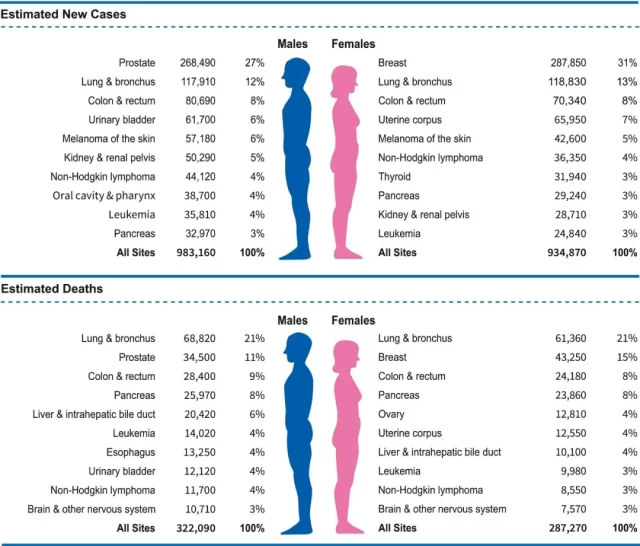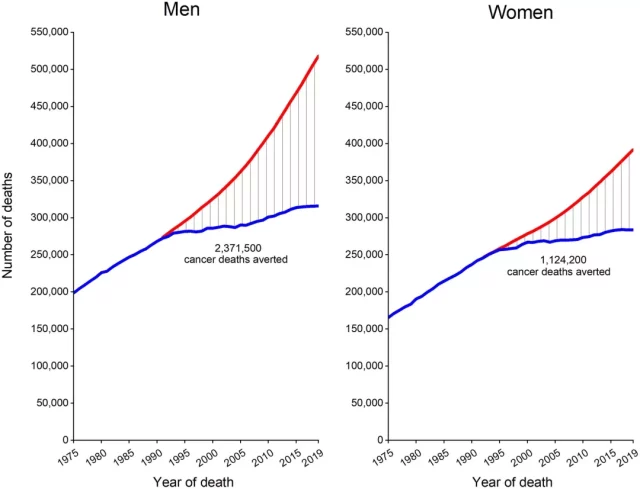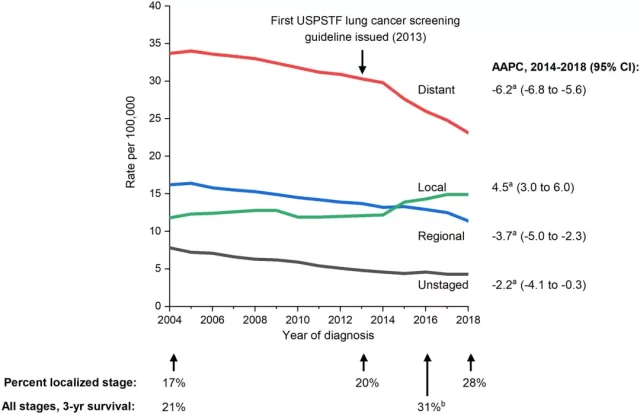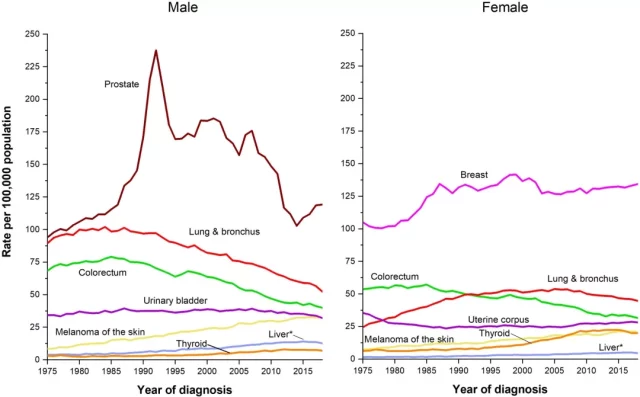The cancer mortality rate in U.S. has dropped by 32% from the peak
- Why Botulinum Toxin Reigns as One of the Deadliest Poisons?
- FDA Approves Pfizer’s One-Time Gene Therapy for Hemophilia B: $3.5 Million per Dose
- Aspirin: Study Finds Greater Benefits for These Colorectal Cancer Patients
- Cancer Can Occur Without Genetic Mutations?
- Statins Lower Blood Lipids: How Long is a Course?
- Warning: Smartwatch Blood Sugar Measurement Deemed Dangerous
The cancer mortality rate in U.S. has dropped by 32% from the peak
- Red Yeast Rice Scare Grips Japan: Over 114 Hospitalized and 5 Deaths
- Long COVID Brain Fog: Blood-Brain Barrier Damage and Persistent Inflammation
- FDA has mandated a top-level black box warning for all marketed CAR-T therapies
- Can people with high blood pressure eat peanuts?
- What is the difference between dopamine and dobutamine?
- How long can the patient live after heart stent surgery?
The cancer mortality rate in U.S. has dropped by 32% from the peak.
The latest cancer statistics from CA: The cancer mortality rate in the United States has dropped by 32% from the peak, the survival rate of lung cancer has improved, and the incidence of breast cancer has slowly increased.
Each year the American Cancer Society (ACS) estimates the number of new cancer cases and deaths in the United States and compiles the latest data on population-based cancer incidence and outcomes.
In 2022, the latest research report (incidence data up to 2018, mortality data up to 2019) was published on January 12 in CA: A Cancer Journal for Clinicians with an impact factor of 508.702.
Data are available on the interactive website Cancer Statistics Center (https://cancerstatisticscenter.cancer.org/#!/).

The risk of dying from cancer in the United States has declined over the past 28 years, the report noted. Cancer death rates fell 32% from a peak in 1991 to 2019.
Some of these declines appear to be related to an increase in the proportion of people with lung cancer who live longer after their diagnosis, and in part because more people are diagnosed earlier in the disease.
Cancer remains the second most common cause of death in the United States after heart disease.
In 2022, the U.S. is expected to add 1.9 million new cancer cases and 609,360 cancer deaths, or about 1,670 deaths per day, with about 350 of those deaths from lung cancer.
Lung cancer is the leading cause of cancer death.
By gender, prostate, lung and bronchial cancer (hereafter referred to as lung cancer) and colorectal cancer account for almost half (48%) of all cases in men in 2022, with prostate cancer alone accounting for 27% of diagnoses.
For women, breast, lung, and colorectal cancers account for 51 percent of all new cancer diagnoses, with breast cancer alone accounting for about one-third (31 percent).

Estimated new cases and deaths by sex in the United States in 2022 for the top ten major cancer types. (Source: CA: A Cancer Journal for Clinicians)
Cancer death rates continue to decline
Cancer death rates fell by 32% between 1991 and 2019 ( last year’s report showed a 31% drop in overall mortality by 2018 ) , which means there were nearly fewer cancer deaths in those years than if the death rate had not declined 3.5 million.
Much of this success is due to a decline in the number of people smoking, which has led to a drop in mortality from lung cancer and other smoking-related cancers.

Number of cancer deaths avoided for U.S. men 1991–2019 and women 1992–2019. The blue line represents the actual number of cancer deaths recorded each year; the red line represents the projected number of cancer deaths if cancer mortality remained at its peak. (Source: CA: A Cancer Journal for Clinicians)
Other factors contributing to the reduction in mortality include:
1) chemotherapy after breast and colon cancer;
2) combination therapy for many cancers;
3) certain cancers (breast, cervix, colon, prostate, rectum, and Lung cancer, etc.) through screening for prevention and/or early detection.
From 2015 to 2019, the risk of dying from cancer decreased by about 2% per year, compared with 1% per year in the 1990s.
The accelerating decline in cancer mortality shows the power of prevention, screening, early diagnosis, treatment, and the overall potential of our progress toward a world free of cancer.
The researchers note that success in reducing cancer mortality requires more investment in two equally important areas:
1) cancer research that expands knowledge and advances better treatment options;
2) ensures successful, targeted Cancer control interventions can be applied more broadly and equitably to all populations.
Advances in early diagnosis of lung cancer
The outlook for lung cancer at all stages of the disease is brighter than ever.
In recent years, an increasing number of lung cancer patients have been diagnosed at an early stage of the cancer, leading to a longer life expectancy.

Incidence trends of different stages of lung cancer diagnosis in the United States from 2004 to 2018. AAPC represents the average annual percentage change. (Source: CA: A Cancer Journal for Clinicians)
From 2014 to 2018, diagnoses of localized-stage disease (no evidence that the cancer has spread outside the lungs) increased by 4.5% per year, while the rate of advanced-stage disease declined sharply.
The result was an overall increase in 3-year survival.
In 2004, 21 out of 100 patients diagnosed with lung cancer were still alive 3 years after diagnosis. By 2018, that number had risen to 31 cases out of 100.
The improvement in survival is largely due to improvements in tests to diagnose lung cancer, video-assisted thoracoscopic surgery (VATS), updates to pathological staging, and drugs targeting the most common genetic mutations in lung cancer.
Here are some other statistics about lung cancer:
- Lung cancer still kills more than 350 people every day, the most of any type of cancer, more than breast, prostate and pancreatic cancers combined. It is responsible for 2.5 times as many deaths as colorectal cancer, the second leading cause of cancer death in the United States.
- Eight out of 10 (81%) of lung cancer deaths in 2022 are expected to be caused by smoking. Both the amount and duration of smoking increase the risk of dying from lung cancer. People who smoke are 25 times more likely to develop lung cancer than those who never smoke.
- Secondhand smoke is responsible for nearly 3% of new lung cancer diagnoses. In 2022, secondhand smoke is expected to cause about 3% of these deaths.
- After smoking, the next leading cause of lung cancer is exposure to radon. Radon gas is released from the soil and accumulates indoors.
- If non-smoking-related deaths from lung cancer were classified separately, it would rank eighth among the causes of cancer deaths.
Prostate cancer death risk decline stabilizes
From the mid-1990s to the mid-2010s, the risk of dying from prostate cancer decreased by about 50% due to improved treatment and screening with prostate-specific antigen (PSA) testing, which helps detect cancer at an early stage ( only in the prostate).
But in recent years, the risk of dying from prostate cancer has dropped by only 0.6% per year.
The reason for the slow progress may be related to changes in cancer screening guidelines.
Although screening helps reduce mortality, there is growing evidence that PSA testing is doing undue harm through overdiagnosis and overtreatment of prostate cancer.
As a result, the United States Preventive Services Task Force (USPSTF) changed their screening guidelines.
In 2008, the USPSTF recommended not routine PSA screening for men 75 years of age and older, and in 2012, PSA testing was not performed for all men.
Initially, after PSA testing was reduced, prostate cancer diagnoses dropped rapidly.
But from 2014 to 2018, the incidence of localized stage disease (no evidence that the cancer has spread outside the prostate) remained stable, while the incidence of regional stage disease (cancer spread to structures or lymph nodes near the prostate) increased by 4% per year, the incidence of distal-stage disease (cancer that has spread to distant parts of the body, such as the brain, bones, liver) is rising by 6% per year.
As a result, the proportion of patients diagnosed with distal-stage prostate cancer has more than doubled over the past 10 years, from 3.9% to 8.2%.

Trends in selected cancer incidence rates by sex in the United States from 1975 to 2018. (Source: CA: A Cancer Journal for Clinicians)
Controversy remains about the underutilized potential of PSA testing to “reduce prostate cancer mortality through early detection,” the ACS researchers noted.
Breast cancer incidence is slowly increasing
Since the mid-2000s, the incidence of breast cancer in women has been increasing at a slow rate of about 0.5% per year.
The rise in diagnoses is partly due to more women being obese, having fewer children, or having their first child after age 30.
The rate of decline in breast cancer mortality has slowed in recent years, which may be related to rising incidence and unchanged mammography rates.
Childhood and adolescent cancer death rates have dropped significantly
Cancer is the second most common cause of death among children ages 1 to 14 in the United States. Accidents are the most common cause.
In 2022, an estimated 10,470 children will be diagnosed with cancer and 1,050 children will die of cancer.
Although childhood cancer rates have risen since the mid-1970s, childhood cancer mortality rates have declined by 71 percent since 1970, largely due to improved treatment and more children participating in clinical trials.
Leukemia remains the most common childhood cancer, accounting for 28% of all cancers in children. From 1970 to 2019, the death rate from leukemia dropped by 84%.
Brain and other nervous system tumors are the second most common type of childhood cancer, accounting for 26% of all childhood cancers.
Cancer is the fourth most common cause of death among 15- to 19-year-olds.
In 2022, an estimated 5,480 teens will be diagnosed with cancer and 550 will die of cancer.
Similar to children, teenage cancer rates have risen slightly over the decades, while cancer death rates have fallen by 61% from 1970 to 2019.
Brain and other nervous system tumors are the most common type of juvenile cancer, accounting for about 21% of juvenile cancers, followed by lymphoma (19%).
For complex reasons, advances in cancer treatment in adolescents have lagged behind that in children.
Reasons include low enrollment in clinical trials, differences in tumor biology and treatment regimens, and treatment tolerance and compliance.
Other highlights of the report
According to the ACS study, at least 42% of projected new cancers are avoidable.
This includes 19% of cancers caused by smoking and at least 18% of cancers caused by a combination of excess weight, alcoholism, malnutrition and physical inactivity.
A new combination immunotherapy for metastatic melanoma, a historically difficult-to-treat cancer, has become a game-changer.
In 2004, only 15 out of 100 patients diagnosed with distal-stage melanoma were still alive five years later.
For patients diagnosed between 2011 and 2017, thanks to these new treatments, the number of patients surviving five years later doubled—30 out of 100.
The incidence of liver cancer, one of the deadliest cancers, has finally stabilized. Just a few years ago, it was the fastest growing cancer.
References:
1# Rebecca L. Siegel MPH et al. Cancer statistics, 2022. CA: A Cancer Journal for Clinicians (2022)
2# Risk of Dying from Cancer Continues to Drop at an Accelerated Pace (ACS)
The cancer mortality rate in U.S. has dropped by 32% from the peak
(source:internet, reference only)
Disclaimer of medicaltrend.org
Important Note: The information provided is for informational purposes only and should not be considered as medical advice.



